| Article ID | Journal | Published Year | Pages | File Type |
|---|---|---|---|---|
| 966104 | Journal of Macroeconomics | 2006 | 23 Pages |
Abstract
This paper develops and estimates a dynamic, stochastic, general-equilibrium model with price and wage rigidities to analyze monetary policy in Canada. A monetary policy rule allows the Bank of Canada to systematically change the short-term nominal interest rate in response to deviations of inflation, output, and money growth. The structural parameters of the model are estimated econometrically using a maximum-likelihood procedure with a Kalman filter. The estimates reveal that either price or wage rigidities are key nominal frictions that generate real monetary effects. Furthermore, the simulation results show that the Bank has, since 1981, increased the short-term nominal interest rate in response to exogenous positive demand-side disturbances, and used modest but persistent reductions in the nominal interest rate to accommodate positive technology shocks.
Keywords
Related Topics
Social Sciences and Humanities
Economics, Econometrics and Finance
Economics and Econometrics
Authors
Ali Dib,
